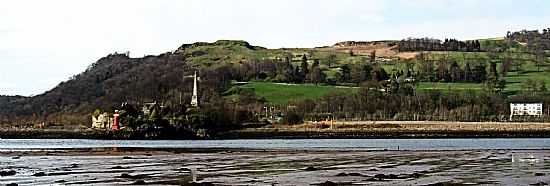SHEEP HILL FORT, Auchentorlie, above Milton.
Also locally known as the Elephant's Head due to its profile overlooking the Clyde. Others consider that that same outcrop looks like a giant's head with the lower section behind it the neck and the longer stretch the body. From that we have the Sleeping Giant.
ACCESS : Restricted. Within quarry property.
This is a scheduled monument.
This is an ancient iron age hillfort on the strategic dun or hill overlooking the Clyde and beyond. This is known as Sheephill although it has also been referred to as Ardconnell. Not to be confused with the even more dramatic hill over Dumbuckhill Quarry.
Canmore tells us that when it was excavated it was shown to have been occupied over two periods : the earlier and smaller being the vitrified fort on the very summit of the knoll. One stretch of vitrified core is visible on the SW, but most of the rubble from the wall, reddened by heat, was removed to build the rampart of a larger enclosure which can be traced around the edges of the lower rock terraces. This later fort also has a triangular, lower enclosure on the S with a gateway visible in its E wall. A short traverse protects this gate. [Canmore].
The term vitrified fort is used. Exact explanations of how this occurred and why are elusive, but what is certain is that great temperatures were reached, whether intentionally or by accident and that the very rocks of the forts were fused together to some extent. This has evidently happened here. For an explanation, see the link below.
John Bruce writes about it being discovered in his own presence by the properietor of the estate, G. J. Ferguson Buchanan, Esquire and subsequently excavated by the Helensburgh Naturalist and Antiquarian Society at te request of the Society of Antiquaries of Scotland. He describes it as being of large extent, and has been protected by earthworks on the southern slope of the hill, the precipitous face of the hill to the west, north and east dispensing eith the necessity of any artificial defences. The vitrification is very marked, and in some places the stones adhere to the living rock, in others the vitrification appears on the top of loose stones, the lower portions of which have been untouched by fire.
The fort is in close proximity to the active commercial quarry which now encircles it. This has led to concerns about its survival. It has been a major feature of Dumbarton ever since the area was developed as a town and, as seen by the fort on top, even back into ancient times. Quite how we value such natural features may differ with each of us, but as a backdrop to the town, we may be all the more distressed if it is altered by quarry operations. Its historical importance may be less obvious.

A winter sunrise as seen from above Renton. The hills are outlined in silhouette and this emphasises the profile of Sheephill to the right with the Langcraigs to the left. Paterson's Dumbuck Quarry is just the other side of the gap..
PastMap records several ancient cup and ring marked rocks on the quarry periphery as well as the find of an ancient bracelet. (Some excellent ones were removed for safekeeping in the National Museum in Edinburgh). John Bruce writes of Mr. W. A. Donnelly, the well-known artist again in his own company, discovering cup and ring markings on rock within a hollow to the north west. These are illustrated in Bruce's book (reference below). Also see Cochno Stones index.asp?pageid=715987.
 This view as seen from the mudflats at low tide shows Dumbuck Hill on the left and Sheep Hill on the right.
This view as seen from the mudflats at low tide shows Dumbuck Hill on the left and Sheep Hill on the right.

In this view from across the Clyde Sheephill appears more prominent. The quarry can be seen. On the shore in front is Dunglass Castle.
BRUCE, JOHN, History of the Parish of West or Old Kilpatrick and of the Church and certain lands in the Parish of East or New Kilpatrick. 1893. Republished by the Clydebank District Libaries and Museums Department, 1995. ISBN096938112. (Reference above p 318).
CANMORE : https://canmore.org.uk/site/43388/sheep-hill
AMUSING PLANET : https://www.amusingplanet.com/2019/08/the-vitrified-forts-of-scotland.html on vitrified hillforts.
WIKIPEDIA : https://en.wikipedia.org/wiki/Vitrified_fort#:~:text=Vitrified%20forts%20are%20stone%20enclosures%20whose%20walls%20have,generally%20situated%20on%20hills%20offering%20strong%20defensive%20positions. on vitrified hillforts.

